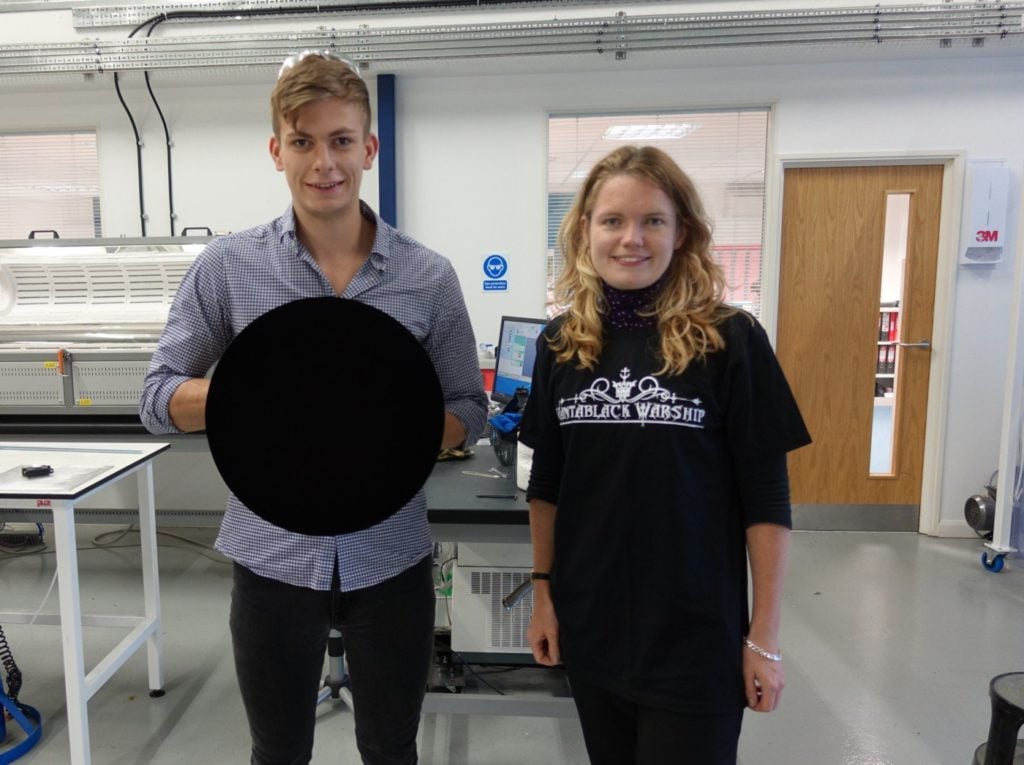Art World
Behold the New Vantablack 2.0, the Art Material So Black It Eats Lasers and Flattens Reality
You have to not see it to believe it.

You have to not see it to believe it.

Sarah Cascone

Artists the world over were instantly captivated three years ago when UK-based Surrey NanoSystems announced the invention of Vantablack, the darkest material ever made. And things continue to get darker: The company has been advancing the technology, and released some astonishing photographs and footage of the pigment in action, which have to be seen to be believed.
A video released last year by Surrey’s scientists shows a “new development of the Vantablack process… a coating so black that our spectrometers can’t measure it!” When a laser pointer is aimed at the Vantablack-coated surface, it vanishes completely, as if no light were touching it at all.
In fact, since Vantablack absorbs 99.96 percent of the incident light that it comes into contact with, any object coated in it looks to the naked eye like a flat, bottomless void in space.
“If you see it on a 3-D object, like crinkled foil, the coated side still looks like a black two-dimensional flat surface. It’s only when you turn it around and you realize that it’s got a lot of dimensionality, that you grasp how different it is,” Surrey NanoSystems chief technical officer Ben Jensen told ABC recently.

Two research scientists showing an object coated with VBx1 super-black paint. Courtesy of Surrey NanoSystems.
When we last checked in on Vantablack, the only way to create it was to chemically grow a dense network of impossibly tiny, densely packed carbon nanotubes in a special high-heat chamber on a substrate such as aluminum. Last year, Surrey NanoSystems developed a spray paint version, Vantablack S-VIS. “If required, objects up to a metre or more in length can be sprayed, providing very great flexibility of application,” the company boasts.

A Surrey NanoSystems technician demonstrating a three-dimensional bowl-shaped object spray-coated with the new paint. Image courtesy Surrey NanoSystems.
One astonishing example of the Vantablack paint at work shows two identical cast-bronze heads, one coated in a newly developed non-nanotube super-black paint. The first is burnished and golden, with a heavy brow and bulbous nose. The second, though identical in form, appears as an empty black space, an unnerving ovular mass that bears no evidence of the facial features on the surface.
Already upon its release, celebrated British artist Anish Kapoor recognized the incredible possibilities of this new material, enlisting its inventors to help him develop ways to use the new “super black” for artistic applications. As part of the arrangement, he asked that Surrey NanoSystems work exclusively with him, leading to a bit of a firestorm in the artistic community, and at least one very personal Instagram feud with an artist who believes Kapoor should let others experiment with the new material.

Anish Kapoor, Sequential One S110 Evo Vantablack watch. Courtesy of Manufacture Contemporaine du Temps.
Kapoor has already unveiled one commercial project, the Sequential One S110 Evo Vantablack luxury watch from Manufacture Contemporaine du Temps watches, sold in an edition of 10. The dial and the minute hand are coated in Vantablack. The new photos suggest much more mind-altering uses are closer and closer to hand.
Vantablack is “the blackest material in the universe after a black hole,” Kapoor told artnet News recently. “It’s literally as if you could disappear into it.”